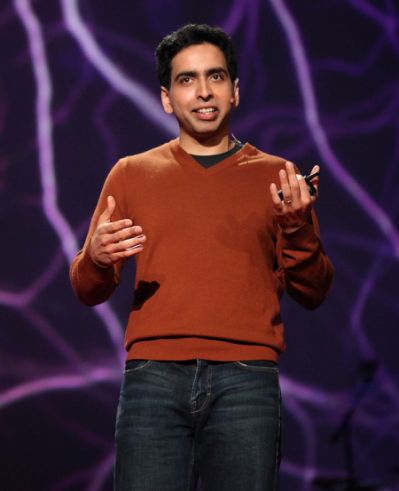Education Reimagined: Visionary Sal Khan Visits Scarsdale
- Category: On Our Radar
- Published: Tuesday, 09 April 2019 07:38
- Alexandra Wilson

The TIME’s Top 100 Most Influential People winner came to Scarsdale High School on Wednesday, April 3rd to make a presentation to a full auditorium, followed by a fireside chat with Superintendent Dr. Thomas Hagerman. Many were teary-eyed in the audience as he shared his ideas and story:
Khan began working at a hedge fund in 2003 after graduating from business school. In 2004, a cousin of his asked for help with math after she was placed in a remedial math class. After a few weeks of working with her, the cousin took the placement test again and was placed in the advanced math class. Khan felt invigorated by this experience and began tutoring about 15 of his other cousins. One family member suggested that instead of tutoring his cousins individually, he should put tutorial videos on Youtube for efficiency’s sake; while initially reluctant about this proposition, Khan began making videos and putting them on the web. Khan soon realized that non-family members were watching when the comments sections began to swell with positive feedback.
This hobby evolved into a passion that drove Khan to quit his day job in 2009 to pursue the creation of a non-profit educational organization full-time. By this point, Khan’s one-man operation had tens of thousands of viewers. The first months of running Khan Academy were “stressful” for Khan, who was trying to foster a new family with his wife and spearhead an organization at the same time. The couple ran into financial troubles and began cutting into their savings. However, in May of 2010, a neighbor donated $10,000 to the cause. After Khan met with the generous donor for lunch, she donated $100,000. After struggling to find funding, these donations gave Khan the boost he needed to continue his mission. A couple of months later, the same neighbor notified Khan that Bill Gates was doting on him on television, and Khan could hardly believe what he was seeing when he found the footage. Soon after, Gates’ chief of staff reached out to invite Khan to Seattle so the two could collaborate. From there, Khan Academy soared into an international movement and the team expanded from Khan’s original one-person staff.
There’s a method to Sal Khan’s teaching madness that has already been proven effective in 190 countries in 14 different languages among his 71,000,000 registered users. First, many viewers wonder why Khan and the other tutors never appear in their videos. Khan’s rationale is that when only the tutor’s writing is visible, it feels as though the student and the tutor are looking down at paper on a table, making it feel more personal. Khan believes that the core of learning must be interactive, so he tries to make his videos friendly and entertaining. Furthermore, since humans are wired to steer their attention towards other humans, Khan thought a visible tutor would take away from the lesson. “My unibrow can be distracting,” he joked.
In addition, students can pause or replay the videos at any point they choose, thus preventing them from feeling badly about learning at a slower pace than others. To explain this notion of learning at different speeds, Khan used the metaphor of building a house. He said that if a contractor tells builders, “You have two weeks to build a foundation - do what you can,” then the builders may not be able to perfect it in the given timeframe. When the contract gives a new assignment in a two-week period, the builders may build another imperfect structure upon an already shaky foundation. This pattern would continue until the whole building collapses. Khan equated this to education by saying that students may have gaps in their learning if they try to learn too fast before an exam, making Khan Academy an excellent supplementary tool.
While the story of Khan Academy’s birth is inspiring, the part of the presentation that brought tears to Scarsdale residents’ eyes were the stories of students whose lives have been changed by Sal Khan. He notably mentioned one boy who had dropped out of high school twice during his freshman year, and when he came back to school, he used Khan Academy to catch up. The student then jumped two years in math, graduated as valedictorian, studied computer science at Princeton, and was hired as an engineer at Khan Academy after interning for them. Khan told another story of a Mongolian orphan who used Khan Academy to educate herself and is now a Mongolian translator for the organization. Another family told Khan that they pray for him every night because of the impact he has had on their kids with learning disabilities. These are only a few of the millions of students whose education has been changed by Khan Academy and Sal Khan’s mission.
Has Sal Khan achieved his goal of creating “a free, world-class education for anyone, anywhere”? In a little over a decade, he’s come closer than virtually anyone, and he doesn’t plan on stopping now.







